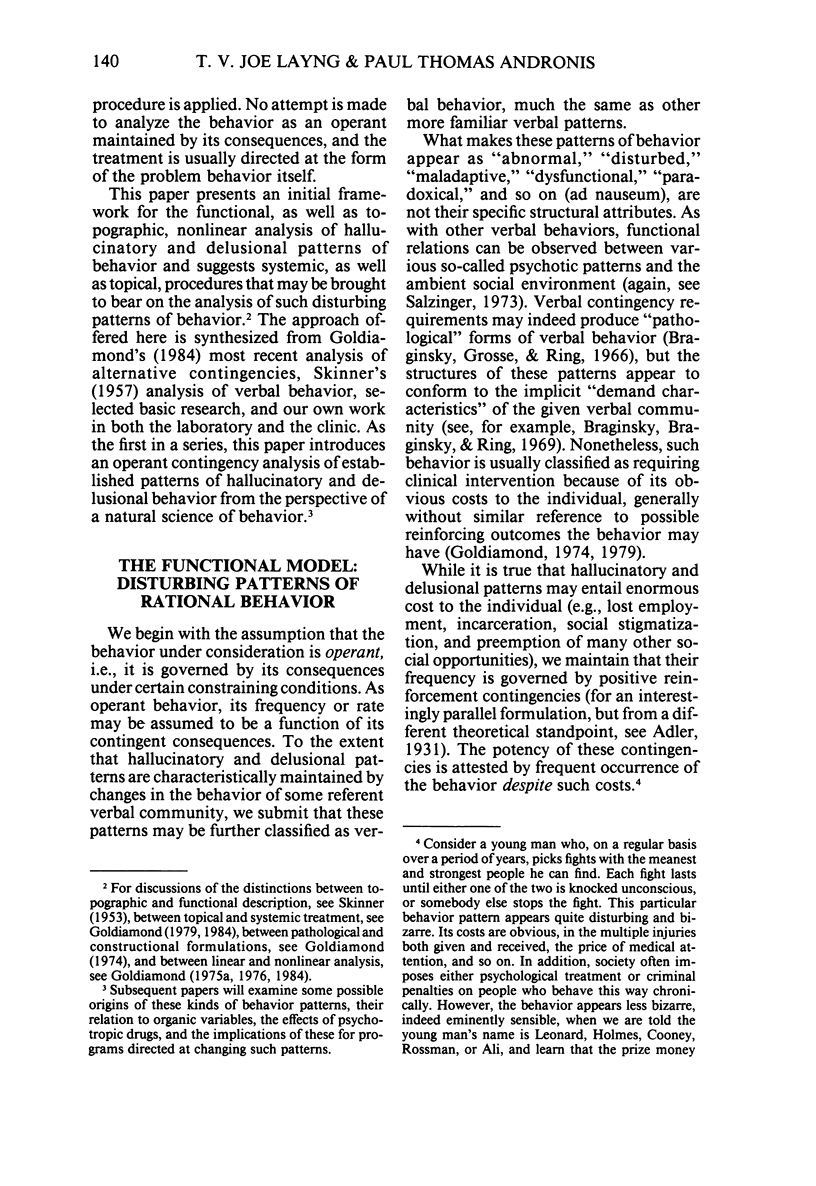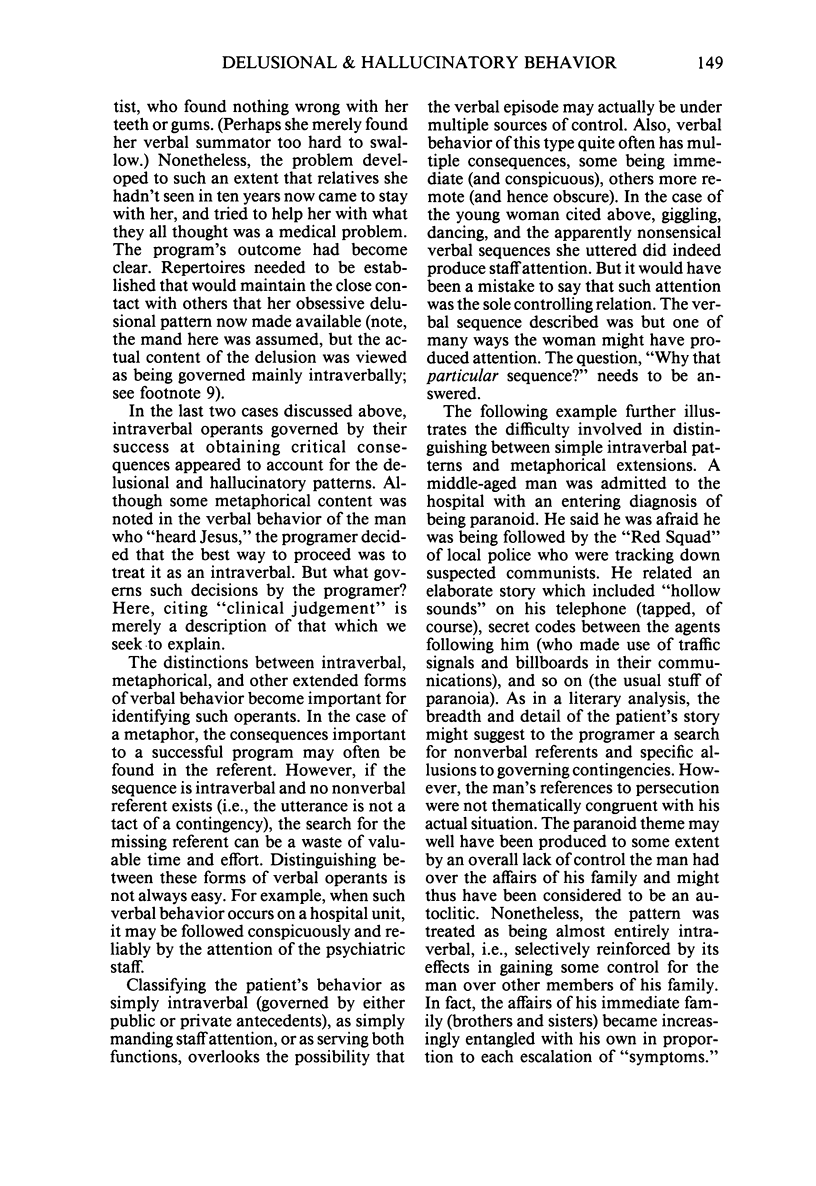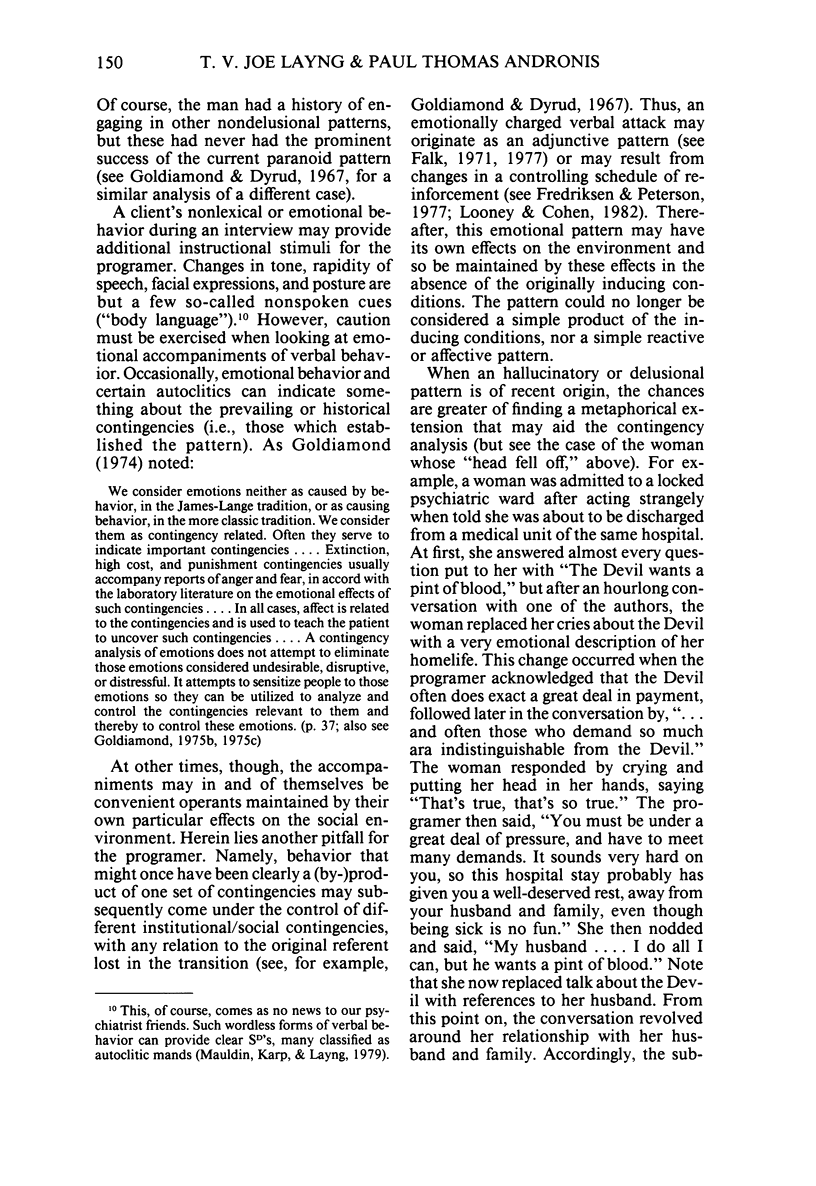Abstract
An approach to a functional analysis of delusional speech and hallucinatory behavior is described and discussed using concepts found in Goldiamond's (1975a and 1984) nonlinear contingency analysis and Skinner's Verbal Behavior (1957). This synthesis draws upon and concords with research from the animal laboratory, with the extensive experimental literatures on stimulus control and signal detection theory, and with our own clinical experiences.
In this formulation, delusional speech and hallucinatory behavior are viewed as successful operants. Accordingly, we argue that such behaviors can be considered adaptive and rational, rather than maladaptive and irrational, when analyzed within a model of consequential governance that includes alternative sets of contingencies. Several clinical examples are offered to illustrate both analytic procedures and the design of systemic treatment programs based upon a behavioral contingency analysis derived from a natural science of behavior. Throughout, we emphasize the consequential governance of these clinically important classes of behavior, in contrast to other approaches which suggest formal similarities to operant verbal behavior but largely ignore the role of consequential contingencies.
Full text
PDF

















Selected References
These references are in PubMed. This may not be the complete list of references from this article.
- Burns C. E., Heiby E. M., Tharp R. G. A verbal behavior analysis of auditory hallucinations. Behav Anal. 1983 Fall;6(2):133–143. doi: 10.1007/BF03392392. [DOI] [PMC free article] [PubMed] [Google Scholar]
- Dunham P. J., Grantmyre J. Changes in a multiple-response repertoire during response-contingent punishment and response restriction: Sequential relationships. J Exp Anal Behav. 1982 Jan;37(1):123–133. doi: 10.1901/jeab.1982.37-123. [DOI] [PMC free article] [PubMed] [Google Scholar]
- Epstein R., Skinner B. F. Resurgence of responding after the cessation of response-independent reinforcement. Proc Natl Acad Sci U S A. 1980 Oct;77(10):6251–6253. doi: 10.1073/pnas.77.10.6251. [DOI] [PMC free article] [PubMed] [Google Scholar]
- Falk J. L. The nature and determinants of adjunctive behavior. Physiol Behav. 1971 May;6(5):577–588. doi: 10.1016/0031-9384(71)90209-5. [DOI] [PubMed] [Google Scholar]
- Freedman B. J. The subjective experience of perceptual and cognitive disturbances in schizophrenia. A review of autobiographical accounts. Arch Gen Psychiatry. 1974 Mar;30(3):333–340. doi: 10.1001/archpsyc.1974.01760090047008. [DOI] [PubMed] [Google Scholar]
- GOLDIAMOND I., HAWKINS W. F. Vexierversuch: the log relationship between word-frequency and recognition obtained in the absence of stimulus words. J Exp Psychol. 1958 Dec;56(6):457–463. doi: 10.1037/h0043051. [DOI] [PubMed] [Google Scholar]
- GOULD L. N. Verbal hallucinations as automatic speech; the reactivation of dormant speech habit. Am J Psychiatry. 1950 Aug;107(2):110–119. doi: 10.1176/ajp.107.2.110. [DOI] [PubMed] [Google Scholar]
- Garza R. D., Johanson C. E. The discriminative stimulus properties of cocaine in the rhesus monkey. Pharmacol Biochem Behav. 1983 Jul;19(1):145–148. doi: 10.1016/0091-3057(83)90323-4. [DOI] [PubMed] [Google Scholar]
- Goldiamond Israel. Protection of human subjects and patients: a social contingency analysis of distinctions between research and practice, and its implications. Behaviorism. 1976 Spring;4(1):1–41. [PubMed] [Google Scholar]
- Goldiamond Israel. Toward a constructional approach to social problems: ethical and constitutional issues raised by applied behavior analysis. Behaviorism. 1974 Spring;2(1):1–84. [PubMed] [Google Scholar]
- ISAACS W., THOMAS J., GOLDIAMOND I. Application of operant conditioning to reinstate verbal behavior in psychotics. J Speech Hear Disord. 1960 Feb;25:8–12. doi: 10.1044/jshd.2501.08. [DOI] [PubMed] [Google Scholar]
- Looney T. A., Cohen P. S. Aggression induced by intermittent positive reinforcement. Neurosci Biobehav Rev. 1982 Spring;6(1):15–37. doi: 10.1016/0149-7634(82)90004-5. [DOI] [PubMed] [Google Scholar]
- Lyon D. O. Concurrent behavior: are the interpretations mutually exclusive? Behav Anal. 1982 Fall;5(2):175–187. doi: 10.1007/BF03392385. [DOI] [PMC free article] [PubMed] [Google Scholar]
- McGuigan F. J. Covert oral behavior and auditory hallucinations. Psychophysiology. 1966 Jul;3(1):73–80. doi: 10.1111/j.1469-8986.1966.tb02682.x. [DOI] [PubMed] [Google Scholar]
- Michael J. Distinguishing between discriminative and motivational functions of stimuli. J Exp Anal Behav. 1982 Jan;37(1):149–155. doi: 10.1901/jeab.1982.37-149. [DOI] [PMC free article] [PubMed] [Google Scholar]
- REYNOLDS G. S. Behavioral contrast. J Exp Anal Behav. 1961 Jan;4:57–71. doi: 10.1901/jeab.1961.4-57. [DOI] [PMC free article] [PubMed] [Google Scholar]
- Sidman M. Normal Sources of Pathological Behavior. Science. 1960 Jul 8;132(3419):61–68. doi: 10.1126/science.132.3419.61. [DOI] [PubMed] [Google Scholar]
- Stoddard L. T., Sidman M. The removal and restoration of stimulus control. J Exp Anal Behav. 1971 Sep;16(2):143–154. doi: 10.1901/jeab.1971.16-143. [DOI] [PMC free article] [PubMed] [Google Scholar]


